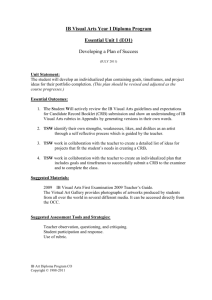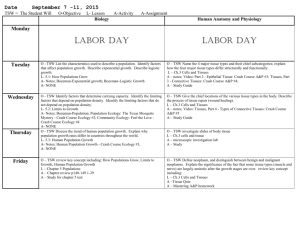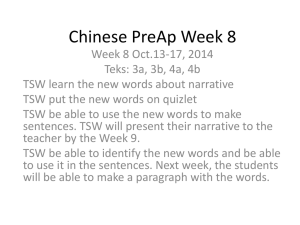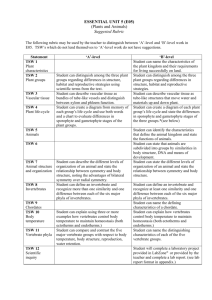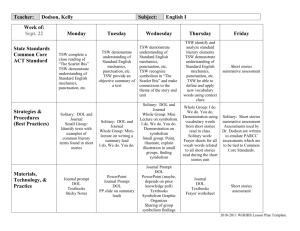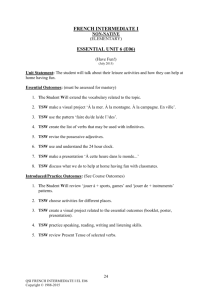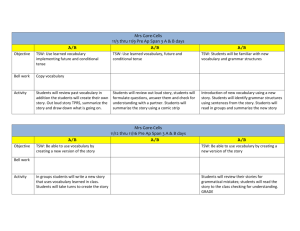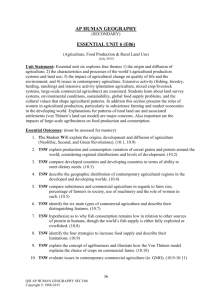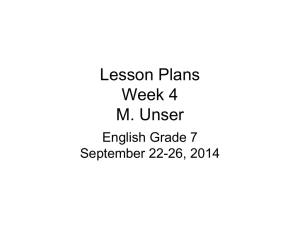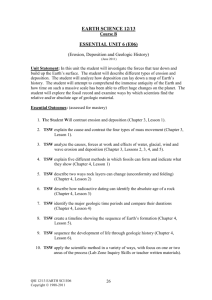MATH-11 E06
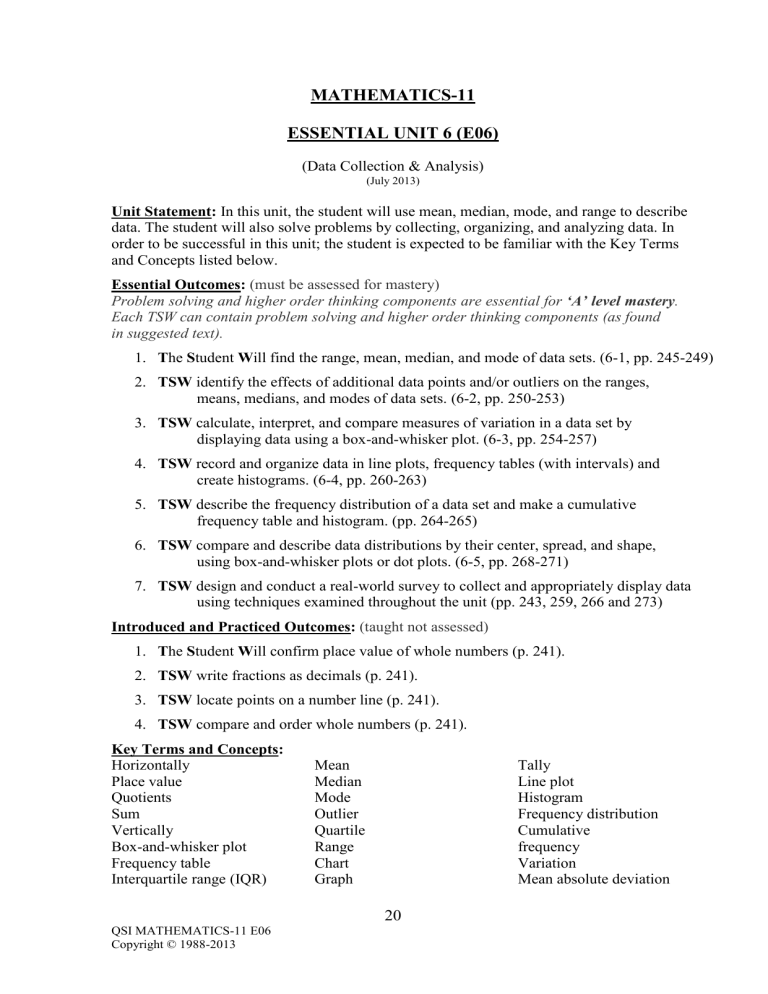
MATHEMATICS-11
ESSENTIAL UNIT 6 (E06)
(Data Collection & Analysis)
(July 2013)
Unit Statement: In this unit, the student will use mean, median, mode, and range to describe data. The student will also solve problems by collecting, organizing, and analyzing data. In order to be successful in this unit; the student is expected to be familiar with the Key Terms and Concepts listed below.
Essential Outcomes: (must be assessed for mastery)
Problem solving and higher order thinking components are essential for ‘A’ level mastery.
Each TSW can contain problem solving and higher order thinking components (as found in suggested text).
1.
T he S tudent W ill find the range, mean, median, and mode of data sets. (6-1, pp. 245-249)
2.
TSW identify the effects of additional data points and/or outliers on the ranges, means, medians, and modes of data sets. (6-2, pp. 250-253)
3.
TSW calculate, interpret, and compare measures of variation in a data set by displaying data using a box-and-whisker plot.
(6-3, pp. 254-257)
4.
TSW record and organize data in line plots, frequency tables (with intervals) and create histograms.
(6-4, pp. 260-263)
5.
TSW describe the frequency distribution of a data set and make a cumulative frequency table and histogram. (pp. 264-265)
6.
TSW compare and describe data distributions by their center, spread, and shape, using box-and-whisker plots or dot plots. (6-5, pp. 268-271)
7.
TSW design and conduct a real-world survey to collect and appropriately display data using techniques examined throughout the unit (pp. 243, 259, 266 and 273)
Introduced and Practiced Outcomes: (taught not assessed)
1.
T he S tudent W ill confirm place value of whole numbers (p. 241).
2.
TSW write fractions as decimals (p. 241).
3.
TSW locate points on a number line (p. 241).
4.
TSW compare and order whole numbers (p. 241).
Key Terms and Concepts:
Horizontally
Place value
Mean
Median
Tally
Line plot
Quotients
Sum
Vertically
Box-and-whisker plot
Frequency table
Interquartile range (IQR)
Mode
Outlier
Quartile
Range
Chart
Graph
Histogram
Frequency distribution
Cumulative frequency
Variation
Mean absolute deviation
20
QSI MATHEMATICS-11 E06
Copyright © 1988-2013
Suggested Materials:
Teacher’s Edition, Chapter 6, Holt McDougal, Mathematics, grade 6.
Suggested Assessment Tools and Strategies:
Attached rubric or teacher generated rubric that assesses ALL essential outcomes
(TSWs).
Assessments created by the teacher (ExamView CD-ROM).
Chapter 6 tests on the ‘Teacher One Stop’ CD-ROM or in the Assessment
Resources (Holt McDougal, Mathematics, Grade 6)
Students keep a journal in which they write about real-life situations connected to their TSW’s. Students use this same journal to rewrite explanations given as paragraphs as steps or a list (TE: p. 45).
Students design, create, and play a game (Don’t Say the Word, Memory,
Pictionary, Scrabble, Word Wall, etc.) where they can prove their understanding of the Key Terms and Concepts (TSW 1-6).
Additional Resources:
The World Almanac for Kids edited by C. Alan Joyce et al. (see page 243 TE).
Technology Links:
Destiny WebPath Express (school library site)
Lesson Tutorial Videos for every lesson (CD-ROM, Holt McDougal, Mathematics,
Grade 6)
Power Point Presentations for every lesson (CD-ROM; Teacher One Stop, Holt
McDougal, Mathematics, Grade 6)
http://my.hrw.com
(Holt McDougal's online math tools)
www.ixl.com/math (online practice for students)
www.tenmarks.com
(online supplemental math program)
www.khanacademy.org
(online practice for students)
Suggested rubric found on following page……..
21
QSI MATHEMATICS-11 E06
Copyright © 1988-2013
SUGGESTED RUBRIC MATH-11 E06
Student Name: __________________________ Date: _______________________
To receive a ‘B’, the student must show ‘B’ level mastery on ALL Essential Outcomes (TSW’s).
To receive an ‘A’, the student must show ‘A’ level mastery on all three available TSW’s and
‘B’ level mastery on all of the remaining TSW’s.
TSW
1- TSW find the range, mean, median, and mode of a data set.
‘A’ LEVEL ‘B’ LEVEL
The student is consistent in finding the correct range, mean, median, and mode of a set of data.
Notes
2- identify the effects of additional data points and/or outliers on the ranges, means, medians, and modes of data sets.
3- calculate, interpret, and compare measures of variation in a data set by displaying data using a box-and-whisker plot.
The student is able to justify which method of analyzing data (mean, media, etc.) is most suitable for a variety of situations.
The student creates his/her own data set that has an interquartile range of a given number and a median of some number and describes how numbers affect the IQR and the mean absolute deviation.
The student can identify the effects of the range, mean, median, and mode consistently.
The student uses a Box-and-
Whisker plot and consistently calculates, interprets, and compares measures of variation in a data set correctly.
4- record and organize data in line plots, frequency tables (with intervals) and create histograms.
The student consistently records and organizes data in line plots and frequency tables.
Histograms are created with appropriate scales and intervals and contain the correct label and title.
5- describe the frequency distribution of a data set and make a cumulative frequency table and histogram.
The student describes the frequency distribution correctly and makes a complete (title, intervals, and frequency) cumulative frequency table and histogram.
6- compare and describe data distributions by their center, spread, and shape.
7- design and conduct a real-world survey to collect and display data.
The student creates challenging questions from his/her survey for other students and critiques their answers correctly.
The student consistently describes the correct center, spread, and shape of data and compares the data correctly.
The student designs and conducts a survey to collect data and displays his/her data in a drawing (histogram, table, etc.) correctly.
22
QSI MATHEMATICS-11 E06
Copyright © 1988-2013

